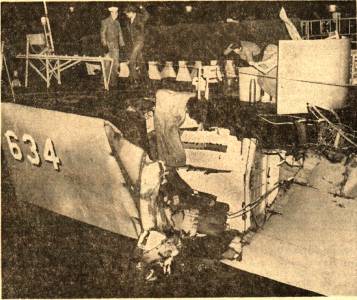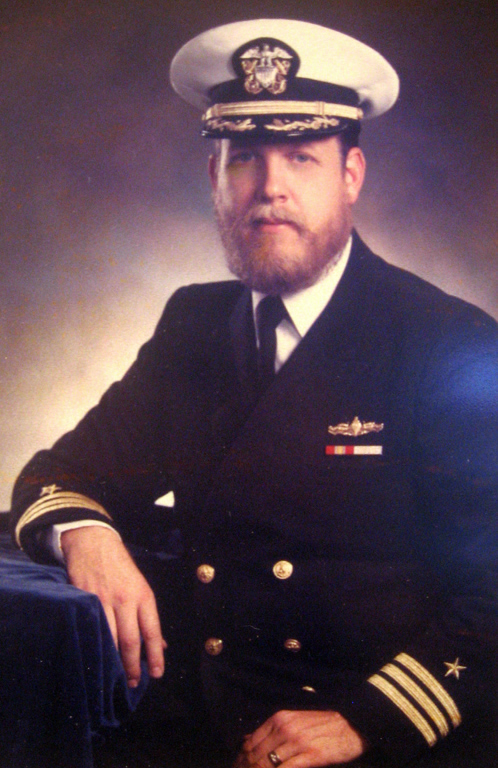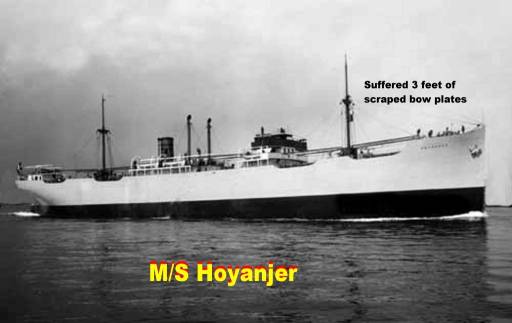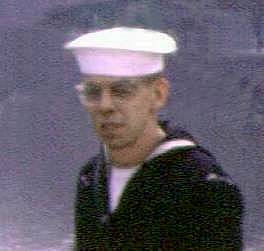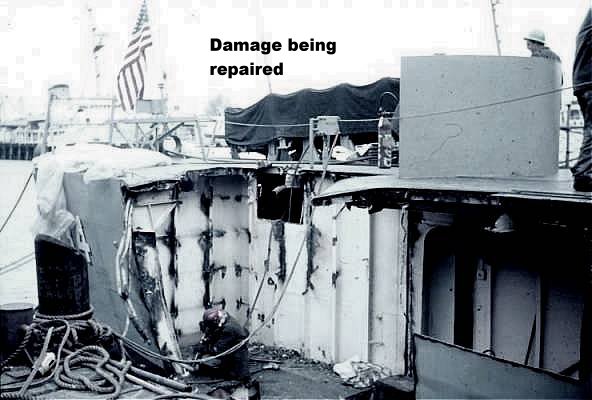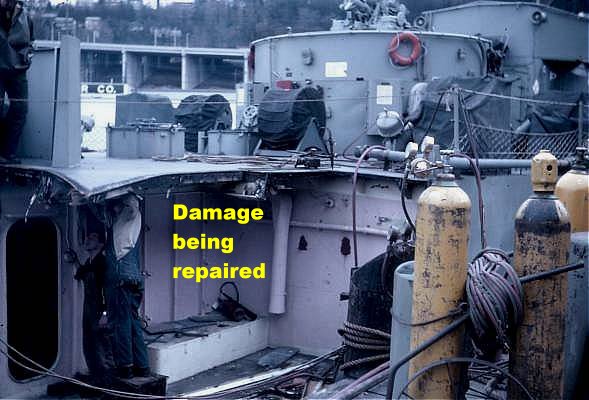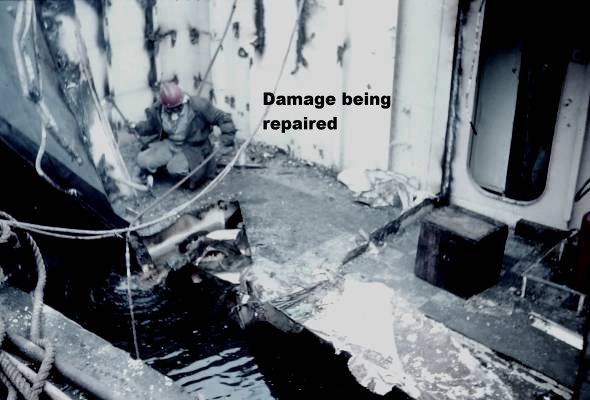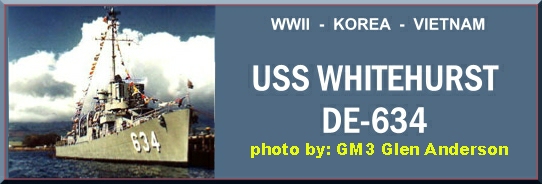
USS Whitehurst Logo by: Pat Stephens, Webmaster, DESA
|
In Dense B.C. Fog: |
|
|
Seattle-Based Warship and Freighter Collide |
|
|
Contributed by Rodger Clement QM3 |
|
|
|
|
|
|
|
|
The Seattle-based Destroyer Escort Whitehurst and the Norwegian freighter Hoyanjer collided in dense fog last night about 7 'o'clock at the entrance to Vancouver Harbor in British Columbia. There were no reports of casualties but Whitehurst
reportedly suffered extensive damage to her stern. the United Press
International said. The Whitehurst was aground about 40 feet from shore, a spokesman for the Air-Sea Rescue Center at Vancouver said, and there was fear she might heel over as the tide ebbed. The Hoyanjer, with a crew of 38 and a general cargo, was towed into English Bay. A spokesman for 13th Naval District Headquarters in Seattle said the Whitehurst was presumed inbound and the freighter outbound when they collided just outside the Lion's Gate Bridge. The spokesman said the Whitehurst, based at pier 91, left Seattle about 8 o'clock yesterday morning on a weekend training cruise with the Brannon, another Seattle-based destroyer escort. Of the 200 men aboard the Whitehurst, all except about 40 are reservists, mostly from the Seattle area, the spokesman said. The Whitehurst is commanded by Lieut. Comdr. Richard Rising, 34 of Bellevue. He assumed command of the vessel in October. The Whitehurst had been scheduled to remain in Vancouver last night, undergo more training today and return to Seattle late in the day. The Air-Sea Rescue Center said the Whitehurst may be refloated this morning if she did not heel over. Witnesses described the damage to Whitehurst as "a long gash on its right side near the stern," the Associated Press said. The Ship's steel plates reportedly buckled and "stuck out five feet." Wayne McRory, 23, a university student, was standing on the back porch of a waterfront house when the collision occurred. "I saw the ship lights coming through the fog and not too far from shore," he said. "I heard someone shouting, apparently trying to sound a warning. The two ships were side by side and heading straight for the beach," McRory added. The Seattle spokesman said the reservists aboard the Whitehurst would return here as scheduled, either aboard other ships or by land. It was not known which vessel hit the other. The Hoyanjer had just passed through the narrow entrance beneath the bridge, an area controlled by radar, and was moving into the wider area beyond. Fog horns at Stanley Park, a 1,000 acre playground on the opposite shore , were sounding. |
|
|
|
|
|
Richard Rising Capt. USN Ret. Relates His Memories of the Collision, July, 2003 |
|
|
|
|
|
DEs Whitehurst and Brannon were cautiously holding back before entering the harbor. DD Brinkley Bass had already passed under the bridge when Hoyanjer came out on the wrong side of the channel. The Norwegian ship was being propelled along with the outgoing current and was probably doing about 15 knots. She collided with Whitehurst driving her almost onto the beach, damaging the starboard side aft and the propellers. Fortunately, there were no injuries. Whitehurst heeled approximately 30 degrees but not over on to her side, as some had feared might happen. The reservists were taken off and returned to Seattle aboard the Brannon and the Brinkley Bass. A Naval inquiry completely vindicated the Commanding Officer of Whitehurst. The Norwegian ship was using no lookout and had almost collided with a ferry before hitting Whitehurst. Several months after the collision the US Government sued the Norwegian Government for repair cost and won the case.
During
this trial ( I was one of the chief witnesses) it came out that the Hoyanger
had no lookouts stationed or anyone tracking traffic on radar. They were
under control of a Pilot that assumed there would be no shipping in the area.
We , and the other two ships of our program (Brinkley Bass, in port, and the
Brannon which was with us), tracked the Hoyanger , sounded the required
signals and maneuvered in accordance to the rules of the road.
A few quotes from the court findings are: " ...the other alternative, and the one followed by the pilot of the Hoyanjer, was to ignore good navigational practices and proceed to " shoot the gap" without stopping even upon hearing a fog signal. Faced with these alternatives, it is difficult for us to criticize Commander Rising for the choices he made" " The master of the Princess of Vancouver indicated to the Navy Board that he too had difficulties in affecting passage with the Hoyanjer in the first narrows".
This collision took place outside of the entrance to
Vancouver harbor. The entrance to the harbor is narrow, so the Whitehurst
and
Brannon wisely decided to remain out in the open sea, until the Hoyanjer
cleared the area.
Our mission in the Navy was to train our crew. Since we were formed as a unit in 1958 we spent one weekend a month training, and two weeks every summer in formal underway training. Our practice was to have a liberty port each month, and one of our annual trips was a port visit to Vancouver BC. Dick Rising CAPT USNR-Ret __________________________________________________________________ Commander Ron Reierson, USNR Ret and Skipper of the North Pacific Chapter of the Destroyer Escort Sailors Assn., has recorded his account of the collision. The following record was first posted in YE OLD SALT'S NEWS, the news letter of DESA NORPAC Oct. 2017, and is published here with CDR Reierson's permission.
Collision at Sea In January, 1965, I was JOOD on the bridge of USS Charles E. Brannon
(DE-446), The ships track bends to starboard around a peninsula and into the Inner Harbor under the Lion's Gate Bridge... a rather narrow transit. By now, darkness had fallen, and due to the fog, we were following International Rule of the Road requirements for slow speed and fog horn signals. There was a 4 - 5 knot ebb current coming out of the Inner Harbor. WHITEHURST was proceeding at 5 knots, making just a couple knots over the ground against this current, careful to stay on her side of the channel. The bridge tender on the harbor frequency ( which we were monitoring also on voice radio and responsible for monitoring traffic in the channel), informed WHITEHURST of the Norwegian freighter, MS HOYANGER, outbound, but no info on how far from his bridge the freighter was at that time. He engaged in only one transmission. Nothing was heard from him again on this developing issue, and his disappearance was unresolved, even after the inquiries. Just west of the bridge, about 200 yards, here comes HOYANGER barreling westerly under the bridge, making ( it was estimated), 10 -12 knots over the ground, in heavy fog, just as WHITEHURST was turning to starboard about 30 degrees for the next leg of the track under the bridge. It was to be a starboard-to-starboard passage. Five short blasts by WHITEHURST could be heard by us and then the collision. Hoyanjer had plowed into the starboard quarter of WHITEHURST, and shortly, with an ebbing current and inertia, pushed WHITEHURST into shoal waters and onto the shore of North Vancouver. HOYANGER then nosed into the shore behind WHITEHURST, but rescue tugs pulled her off before heavy grounding. The same could not be said for WHITEHURST, whose screws and rudder were possibly damaged and she was left high and dry resting on her starboard side. as the tide went out. Little damage was incurred by HOYANGER, and she went on her merry way. All structural damage was above the waterline, but the After Officer's Quarters (Starboard side, just forward of After Steering was a mess). No injuries sustained. My brother was Executive Officer in WHITEHURST. As he later walked the main deck aft, several of the local residents had come down to see this travesty, and since snow had accumulated earlier, were throwing snowballs at our sailors. And, a local TV news reporter walking the beach, asked my brother, in typical Canadian humor: "Did you check in with customs?" The crew stayed with the ship 'til morning when a tug pulled them free, sent them to a repair yard, and the crew was bussed back to Seattle. The Vancouver Sunday newspapers posted the headline "NAVY DESTROYER COLLIDES WITH FREIGHTER". We were already guilty in the press. We in BRANNON, turned around, located a nearby anchorage and dropped the hook, leaving Sunday morning for home, at Pier 91, Naval Supply Depot, Seattle, WA... our home port. Whitehurst was repaired over the next few weeks, and many of the crew returned to Vancouver to bring her home. An International Maritime Hearing was conducted gathering data from both ships. The Navy also convened a "long green table" ... a Board of Inquiry ... in Seattle, where all watch personnel were grilled and questioned as to the particulars. Ship's and Quartermaster Logs were key as well. After all was said and done, actions of the watch standers, (CO, XO, OOD, etc.) and crew were deemed appropriate and prudent under the circumstances. The only comment was that WHITEHURST appeared to be close to the center of the channel; had she been just a bit more to the left (away from center), she might have avoided the collision. However this in no way altered the actions of HOYANGER. WHITEHURST'S C.O. (a LCDR), the X.O. and OOD (Both LT's) were exonerated. All went on to rise to the rank of Captain, USNR prior to retirement. The Maritime Board concluded HOYANGER was negligent in several ways. Speed under the circumstances too high; should have had tug assistance, especially with such a strong ebb current in the narrow channel, and being a single screw ship; lookout not adequately prepared nor posted forward; and the ship was not adjusting to the curve of the track exiting the channel to keep her out of the oncoming lane traffic,, hence the collision. Could have been a lot worse. (Note: this article was edited for accuracy by one of the bridge watchstanders on watch during this event)
William J. "Bill" Russonello's Memories of the Collision |
|
Both Brannon and Whitehurst were scheduled for annual drills that weekend. Although I was Aide to Com13, I was the only officer available that weekend to oversee the engineering drills and was assigned to do just that aboard Whitehurst on Saturday and Brannon on Sunday. I arrived on board Whitehurst about 0715 Saturday and stowed my gear and dress uniforms in Starboard After Officer's Quarters. At about 0750 Captain Rising and the Chief Engineer said Whitehurst was not as ready to conduct engineering drills as they would like. He asked if I would drill Brannon on Saturday and Whitehurst on Sunday. I agreed, and immediately transferred to Brannon, leaving my gear on Whitehurst. At the end
of the day we had dinner and as there was fog slowing our progress, I
decided to take a short nap in After Officers Quarters on Brannon. To
this day I am convinced I would have been on the same bunk aboard Whitehurst
at the time Hoyanger poked its bow through it. I lost all my gear and
uniforms but not my life. The photos show that compartment completely
destroyed, and had Whitehurst been ready for engineering drills that day,
I would most certainly have been the only fatality of that collision. FATE. QM2 George Williams Was Helmsman at Time of the Collision |
|
I was a QM2 in the reserves, living in Renton in '64, doing my active reserves duty aboard the Whitehurst. We were "center punched" by a Norwegian freighter, the Hoyanger, in a fog in Vancouver Harbor, in or about that same year. I was below in my dress blues, dreaming
of some fine "liberty" when the collision alarm sounded, then the
|
|
|
Photos below contributed by Tim Dorgan |
|
|
|
|
|
|
|
|
|
|
WWII
Era | Korea War &
'50s | Viet Nam & 60s |
Reunions |
All Links Page |
Search & Rescue
Memorial |
Poetry |
Enemy Below |
Taps List |
Photos/Armament |
History |
Crews Index |
Home


